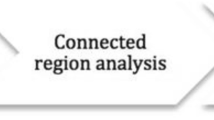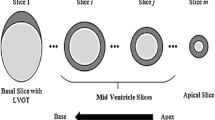Abstract
In this paper, a computational framework is proposed to perform a fully automatic segmentation of the left ventricle (LV) cavity from short-axis cardiac magnetic resonance (CMR) images. In the initial phase, the region of interest (ROI) is automatically identified on the first image frame of the CMR slices. This is done by partitioning the image into different regions using a standard fuzzy c-means (FCM) clustering algorithm where the LV region is identified according to its intensity, size and circularity in the image. Next, LV segmentation is performed within the identified ROI by using a novel clustering method that utilizes an objective functional with a dissimilarity measure that incorporates a circular shape function. This circular shape-constrained FCM algorithm is able to differentiate pixels with similar intensity but are located in different regions (e.g. LV cavity and non-LV cavity), thus improving the accuracy of the segmentation even in the presence of papillary muscles. In the final step, the segmented LV cavity is propagated to the adjacent image frame to act as the ROI. The segmentation and ROI propagation are then iteratively executed until the segmentation has been performed for the whole cardiac sequence. Experiment results using the LV Segmentation Challenge validation datasets show that our proposed framework can achieve an average perpendicular distance (APD) shift of 2.23 ± 0.50 mm and the Dice metric (DM) index of 0.89 ± 0.03, which is comparable to the existing cutting edge methods. The added advantage over state of the art is that our approach is fully automatic, does not need manual initialization and does not require a prior trained model.







Similar content being viewed by others
References
Bezdek JC (1981) Pattern recognition with fuzzy objective function algorithms. Plenum Press, New York
Boudraa AO (1997) Automated detection of the left ventricular region in magnetic resonance images by fuzzy C-means model. Int J Card Imaging 13(4):347–355
Boudraa AO, Mallet JJ, Besson JE, Bouyoucef SE, Champier J (1993) Left ventricle automated detection method in gated isotopic ventriculography using fuzzy clustering. IEEE Trans Med Imaging 12(3):451–465
Bravo A, Medina R (2008) An unsupervised clustering framework for automatic segmentation of left ventricle cavity in human heart angiograms. Comput Med Imaging Gr 32(5):396–408
Cardiovascular diseases (CVDs) Fact Sheets (online), World Health organization (WHO) (2013). http://www.who.int/mediacentre/factsheets/fs317/en/
Casta C, Clarysse P, Schaerer J, Pousin J (2009) Evaluation of the dynamic deformable elastic template model for the segmentation of the heart in MRI sequences. In: MICCAI 2009 workshop on cardiac MR left ventricle segmentation challenge. MIDAS J
Cocosco CA, Netsch T, Sngas J, Bystrov D, Niessen WJ, Viergever MA (2004) Automatic cardiac region-of-interest computation in cine 3d structural MRI. Int Congr Ser 1268:126–1131
Cocosco C, Niessen W, Netsch T, Vonken E, Lund G, Stork A, Viergever M (2008) Automatic image- driven segmentation of the ventricles in cardiac cine MRI. J Magn Reson Imaging 28(2):366–374
Constantinides C, Chenoune Y, Kachenoura N, Roullot E, Mousseaux E, Herment A, Frouin F (2009) Semi-automated cardiac segmentation on cine magnetic resonance images using GVF-Snake deformable models. In: MICCAI 2009 workshop on cardiac MR left ventricle segmentation challenge. MIDAS J
Huang S, Liu J, Lee LC, Venkatesh SK, Teo LS, Au C, Nowinski WL (2009) Segmentation of the left ventricle from cine MR images using a comprehensive approach. In: MICCAI 2009 workshop on cardiac MR left ventricle segmentation challenge. MIDAS J
Jolly MP (2008) Automatic recovery of the left ventricular blood pool in cardiac cine MR images. Medical image computing and computer assisted intervention—MICCAI 2008, Lecture notes in computer science 5241: 110–118
Jolly MP (2009) Fully automatic left ventricle segmentation in cardiac cine MR images using registration and minimum surfaces. In: MICCAI 2009 workshop on cardiac MR left ventricle segmentation challenge. MIDAS J
Kang D, Woo J, Slomka PJ, Dey D, Germano G, Jay-Kuo C (2012) Heart chambers and whole heart segmentation techniques: review. SPIE J Electron Imaging 21(1):131–139
Kedenburg G, Cocosco C, Kothe U, Niessen W, Vonken E, Viergever M (2006) Automatic cardiac MRI myocardium segmentation using graphcut. Proc SPIE Med Imaging 6144. doi:10.1117/12.653583
Leung SH, Wang SL, Lau WH (2004) Lip image segmentation using fuzzy clustering incorporating an elliptic shape function. IEEE Trans Image Process 13(1):51–62
Lorenzo-Valdés M, Sanchez-Ortiz G, Elkington A, Mohiaddin R, Rueckert D (2004) Segmentation of 4D cardiac MR images using a probabilistic atlas and the EM algorithm. Med Image Anal 8(3):255–265
Lu Y, Radau P, Connelly K, Dick A, Wright G (2009) Automatic image-driven segmentation of left ventricle in cardiac cine MRI. In: MICCAI 2009 workshop on cardiac MR left ventricle segmentation challenge. MIDAS J
Lynch M, Ghita O, Whelan PF (2006) Automatic segmentation of the left ventricle cavity and myocardium in MRI data. Comput Biol Med 36(4):389–407
Marak L, Cousty J, Najman L, Talbot H (2009) 4D Morphological segmentation and the MICCAI LV-segmentation grand challenge. In: MICCAI 2009 workshop on cardiac MR left ventricle segmentation challenge. MIDAS J
Mitchell SC, Lelieveldt BP, van der Geest RJ, Bosch HG, Reiber JH, Sonka M (2001) Multistage hybrid active appearance model matching: segmentation of left and right ventricles in cardiac MR images. IEEE Trans Med Imaging 20(5):415–423
O’Brien S, Ghita O, Whelan PF (2009) Segmenting the left ventricle in 3D using a coupled ASM and a learned non-rigid spatial model. In: MICCAI 2009 workshop on cardiac MR left ventricle segmentation challenge. MIDAS J
O’Brien SP, Ghita O, Whelan PF (2011) A novel model-based 3d + time left ventricular segmentation technique. IEEE Trans Med Imag 30(2):461–474
Pednekar A, Kurkure U, Muthupillai R, Flamm S, Kakadiaris IA (2006) Automated left ventricular segmentation in cardiac mri. IEEE Trans Biomed Eng 53(7):1425–1428
Petitjean C, Dacher JN (2011) A review of segmentation methods in short axis cardiac MR images. Med Image Anal 15(2):169–184
Pluempitiwiriyawej C, Moura J, Wu Y, Ho C (2005) Stacs: new active contour scheme for cardiac mr image segmentation. IEEE Trans Med Imaging 24(5):593–603
Radau P, Lu Y, Connelly K, Paul G, Dick AJ, Wright GA (2009) Evaluation framework for algorithms segmenting short axis cardiac MRI. In: MICCAI 2009 workshop on cardiac MR left ventricle segmentation challenge, 2009. http://smial.sri.utoronto.ca/LV_Challenge/Home.html
Rezaee MR, van der Zwet PJ, Lelieveldt BP, van der Geest RJ, Reiber JH (2000) A multiresolution image segmentation technique based on pyramidal segmentation and fuzzy clustering. IEEE Trans Image Process 9(7):1238–1248
van Assen HC, Danilouchkine MG, Dirksen MS, Reiber JH, Lelieveldt BP (2008) A 3-D active shape model driven by fuzzy inference: application to cardiac CT and MR. IEEE Trans Inf Technol Biomed 12(5):595–605
Weng J, Singh A, Chiu M (1997) Learning-based ventricle detection from cardiac MR and CT images. IEEE Trans Med Imaging 16(4):378–391
Wijnhout J, Hendriksen D, Van Assen H, Van der Geest R (2009) LV challenge LKEB contribution: fully automated myocardial contour detection. In: MICCAI 2009 workshop on cardiac MR left ventricle segmentation challenge. MIDAS J
Yang X, Yeo SY, Lim C, Su Y, Wan M, Zhong L, Tan RS (2013) A framework for auto-segmentation of left ventricle from magnetic resonance images. In: Proceedings of APCOM&ISCM 2013. http://www.sci-en-tech.com/apcom2013/APCOM2013-Proceedings/PDF_FullPaper/1121_XuleiYang.pdf
Yang X, Yeo SY, Su Y, Lim C, Wan M, Zhong L, Tan RS (2013) Left ventricle segmentation by circular shape constrained clustering algorithm. In: Proceedings of APCOM&ISCM 2013. http://www.sci-en-tech.com/apcom2013/APCOM2013-Proceedings/PDF_FullPaper/1890_XuleiYang.pdf
Acknowledgment
The authors thank the anonymous reviewers for their insightful comments and valuable suggestions on the earlier version of this paper.
Author information
Authors and Affiliations
Corresponding author
Appendix: derivation of the partial derivatives of J cs-fcm with respect to i c and j c
Appendix: derivation of the partial derivatives of J cs-fcm with respect to i c and j c
The partial derivative of J cs-fcm (refer to Eq. (6)) with respect to i c is given by
For LV region, if the values of β = 2, then we have
Similarly, the partial derivative of J cs-fcm (refer to Eq. (6)) with respect to j c is given by
This derives Eq. (8) for the updating of i c and j c .
Rights and permissions
About this article
Cite this article
Yang, X., Song, Q. & Su, Y. Automatic segmentation of left ventricle cavity from short-axis cardiac magnetic resonance images. Med Biol Eng Comput 55, 1563–1577 (2017). https://doi.org/10.1007/s11517-017-1614-1
Received:
Accepted:
Published:
Issue Date:
DOI: https://doi.org/10.1007/s11517-017-1614-1




